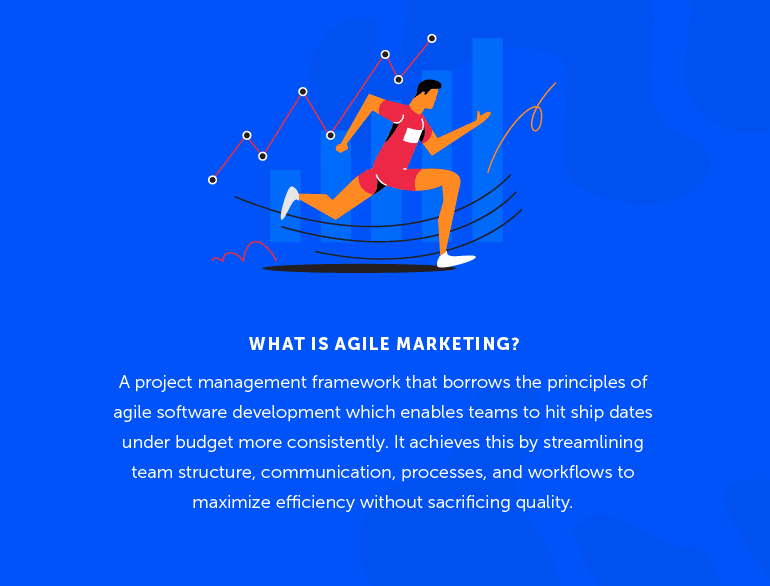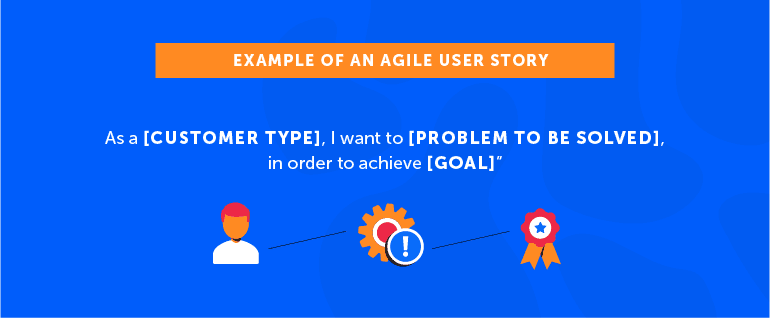The worlds of business and marketing are changing. New technologies are empowering companies to respond to customer demands more quickly and with better data-driven insights than ever before. Those can adapt and execute with speed and precision will enjoy the benefits, while those trapped in an old-school business-as-usual mindset risk becoming irrelevant.
This means marketers must move with the flow of progress too. How can managers make sure their teams are able to keep pace with their competition while remaining flexible enough to adjust to an unpredictable future rather than simply guessing at what might come next?
The answer lies with agile marketing.
With an approach to planning, executing, and measuring projects and campaigns that’s based around rapid iteration and data-backed decision-making, marketing departments within organizations of all sizes can work better, faster, and at less cost.
The results speak for themselves: within a five-year span, agile workflows have helped CoSchedule grow into an industry-leading marketing SaaS company (offering a world-class software suite that helps marketers get organized), landing at number 153 on the Inc. 500 list in 2018 and earning a spot on Gartner’s Magic Quadrant for Content Marketing Platforms.
Implementing such processes isn’t without its challenges. Fortunately though, any company can get started and reap the rewards, transforming even the most stuck-in-the-past teams from cumbersome cost-centers into lean revenue-generating machines. And that is exactly what you’ll learn how to achieve by reading this in-depth guide on going agile today.
Chapter List
- How to Get Started With Agile Marketing and Do Your Best Work (Current Chapter)
- What is the Agile Scrum Framework and How Does It Work For Marketers?
- How to Organize Cross Functional Marketing Teams
- How to Implement a Simple Agile Sprint Planning Process For Marketers
- How to Run Effective Daily Standup Meetings With Busy Marketers
- How to Implement Agile Marketing Workflows With Examples
- How to Improve Marketing Processes With Agile Sprint Retrospectives
Why Create This Guide?
Marketing teams often struggle to meet deadlines and achieve their goals because of inefficient processes and a lack of proper tools to support better ways of working.
Implementing agile principles and workflows, however, can go a long way toward solving these problems for marketing departments across all kinds of verticals. It’s no exaggeration nor hollow marketing claim to state that it has been immensely impactful upon CoSchedule’s growth.
What Can You Expect to Find Here?
There are numerous ways to apply agile to marketing. Like so many other things in this industry, there are also different philosophies and opinions on the best way it should be approached.
With that said, this guide is not necessarily the end-all, be-all authority on the subject. It’s such a broad topic with so many varying approaches that one resource covering every aspect of agile inside and out would be an intimidating challenge (both to create and to read).
Instead, it breaks down the basics of what you need to know, and explains how to actually implement it with easy-to-follow step-by-step instruction. It’s all informed by what has worked for the marketing team at CoSchedule too, blending our own approach with some by-the-book explanation. There’s some (strategic and thoughtful) repetition of information too, so if you don’t quite catch something the first time, you’ll often have an opportunity to hear it again later.
Rather than diving deep into minutiae that may not make sense to newcomers, we thought this approach would be more useful. What matters most above all is that you’re able to put better processes into place so your team can work more efficiently and effectively to get better results in less time. And that’s exactly what we hope you’ll gain as a result of reading this guide.
Download: Get This Guide in One Full PDF
If you would prefer to read this guide in PDF, you can. Download the complete guide in one easy-to-read format below (plus, find additional templates you’ll use in subsequent chapters):
So, What Exactly is Agile Marketing?
It’s a project management framework that borrows the principles of agile software development (which enables teams to hit ship dates under budget more consistently) and applies it to a marketing context. It achieves this by streamlining team structure, communication, processes, and workflows to maximize efficiency without sacrificing quality.
This results in doing better work more quickly with fewer missed deadlines. It also allows teams to respond to changes in the market and adjust tactics according to what works much more rapidly than the typical annual “big campaign” advertising model.

Understanding the History of the Agile
As previously mentioned, marketers borrowed agile from software developers and adapted it to their own needs. But, who had this idea first, and how did they initially influence this change?
For that answer, let’s go back to the early to mid-1900s and the Toyota Production System (TPS). Constrained by limitations on land use and available resources following the second World War, the company devised a method of manufacturing cars that focused on eliminating waste. It was so successful that other car companies quickly adopted similar processes.
Modern agile processes retain many of the basic principles of the TPS. From working to remove unnecessary steps in production pipelines to visualizing workflows from start to finish, this was where the groundwork was first laid down.
In fact, if you’ve ever heard of a kanban board (which visualizes workflows moving in phases from left to right), you can thank Taiichi Ohno, the engineer who created the TPS.

From there, the philosophy spread slowly throughout the business world, and took root in software development sometime in the 1990s. In 2001, it grew more formalized as a philosophy and a practice when a group of developers crafted the Agile Manifesto, a concise summation describing a way of working that was better suited to the quickly shifting needs of a growing technology industry.
Here is a video of Jeff Sutherland (one of the creative minds behind the development of agile) speaking at a TedX event about agile and how it can transform the productivity of any team:
Developing an Agile Marketing Manifesto
What works for one line of work might not necessarily apply directly to another. Eventually, smart marketers came to understand that if agile was going to work for them, it needed some modifications to suit their purposes (not because the existing model was flawed, only that it wasn’t written with them in mind).
So, in 2012, mind mapping software company MindJet hosted an event called SprintZero in San Francisco to document a common framework for agile marketers. This led to the creation of the Agile Marketing Manifesto, a seven-point list of values to guide marketers. The full list reads:
- Validated learning over opinions and conventions.
- Customer focused collaboration over silos and hierarchy.
- Adaptive and iterative campaigns over Big Bang campaigns.
- The process of customer discovery over static prediction.
- Flexible vs. rigid planning.
- Responding to change over following a plan.
- Many small experiments over a few large bets.
Everything else around the execution of agile marketing stems from this simple list. While it may seem basic, it represents a significant shift in thinking toward marketing, and one that is having a growing impact on how companies build and run marketing teams.
What Are the Real Benefits of Going Agile?
Spend five minutes in the marketing industry and you’ll be inundated with more buzz terms and cliches than you’re likely to hear almost anywhere else. Hype generation is part of the game, right? Sure, but so is providing real results based on what actually works.
That’s a good point to lead off into why 50% of traditional marketers plan to adopt agile in the next year. It improves project management and gets measurable results. But, beyond statistics and claims of its greatness, why should you personally care?
Consider the following points.
Agile Increases Efficiency
Eliminating unnecessary steps and red tape means teams work faster. This equals executing more projects, which means more opportunity to bring in customers. Instead of spending time on things that don’t deliver value, you can focus all of your efforts on the most important tasks at hand.
Agile Increases Innovation
By emphasizing rapid testing, marketing teams using agile can discover all kinds of insights much more quickly. That means your marketing efforts can be driven by actual data to provide customers the messaging they’re actually looking for, rather than making guesses.
Plus, by moving more quickly, acting on data, and embracing a fail-fast mindset, you can more easily produce innovative ideas that actually get implemented and drive results.
Agile Delivers More ROI At Less Cost
The old way of doing marketing was often slow, and measurement was sometimes difficult to quantify. Now, thanks to agile processes that empower teams to run multiple campaigns at once without reducing effectiveness, plus the advantages of modern analytics, it’s easier than ever to produce more measurable return on investment at (potentially) less cost.
Agile is Built for Growth
Processes that can’t scale are processes that can’t move you forward. Fortunately, agile is designed with growth in mind. Moreover, it can help teams maintain efficiency even as your team expands over time.
Agile Keeps You Focused On Your Customers
This approach to marketing keeps teams focused on delivering what customers and audiences want without getting bogged down in unnecessary documentation and meetings.
How Does Agile Marketing Work?
So, how exactly do teams achieve all this good stuff? Here’s a breakdown behind how it works.
First, teams are comprised of members from different disciplines (breaking down silos). Those teams meet every day when working on projects. Every project that is executed is intended to answer a user story (a short description of what a customer or audience member wants to do, or a problem they’re having, that your product can solve).
They’re written out like this:
“As a [CUSTOMER TYPE], I want to [PROBLEM TO BE SOLVED], in order to achieve [GOAL]”.
 Next, the team plans out work over short (usually two-week) periods of time called sprints:
Next, the team plans out work over short (usually two-week) periods of time called sprints:

At the end of the sprint, the team reviews how things went (and how it can improve):

Feeling lost? Don’t worry. All of this stuff will be explored and explained in deeper detail later.
Why Doesn’t Everyone Do Marketing the Agile Way?
This all sounds great, but it begs the question of why everyone isn’t working this way already. It’s likely that question can be answered by a few different things, most of which revolve around the fact that disrupting the status quo and influencing change can be difficult.
Sometimes Stakeholders Don’t Want to Change
If things have been going good enough for long enough, people can start to get comfortable.
That’s understandable. What’s comfortable is often what feels safe. And safety feels good, too. You can show up to work, do things the way you’ve always done before, and then punch out without taxing your brain too much.
But, that line of thinking leads down a path of diminishing returns. The waste of neglected inefficiencies piles up. Frustration mounts and pushes talented employees to leave. Forward-thinking competitors with better ways of working get ahead in the marketplace, while status quo companies slide into the dustbin of history. Or, at the very least, never achieve the full greatness they’re capable of reaching.
The Fear of Failure Holds Teams Back
If you’re comfortable, you’re liable to get lazy. Implementing new processes takes time and effort, after all. Add the fear of failure on top of that too, and teams can quickly become inflexible.
This applies both to individuals and to companies as a whole. As much as an organization might try to gird against it, it can still manifest itself in self-sabotaging ways that prevent progress. Consider this quote from the Harvard Business Review:
“People are quick to blame themselves for failure, and companies hedge against it even if they pay lip service to the noble concept of trial and error.”
The takeaway: even if you give team members room to try things and make mistakes (which is essential for agile to succeed), sometimes people still won’t give themselves the room to try and fail and try again if they’re worried they’ll be blamed when things go wrong.
General Skepticism
Finally, some people are just skeptical. There could be something about agile that doesn’t seem applicable to their situation, or on its face, just doesn’t appeal to them. In other words, they just might legitimately see things differently than agile evangelists.
Even if you’re sold on implementing agile, if a stakeholder (like your boss, or someone in another department that you’re dependent on for collaboration or approval) has a differing opinion, you might need to know how to build a case and be persuasive (hopefully, this guide can help you here).
What’s Needed to Implement Agile Successfully?
Before you decide to change your team’s workflow and approach to project management, there are some basic items you’ll need to keep in mind in order to maximize your odds of success.
Openness to Change
Being a champion for change in your organization can be intimidating. But, it helps to be open to the idea of change itself from the get-go. In short, your odds for success will increase if you can get comfortable with knowing you might not always know what you’re doing, and things might not always go to plan at first, but in the long-term your marketing and work-life will improve.
Buy-in From Stakeholders
If team members, managers, and department heads are expected to execute something new, they will need to be on board with the decision in order to implement it effectively. Otherwise, forcing new processes onto a begrudging team may be a set up for failure in the long run.
Tools That Support Agile
Whether you use a marker board or software, your project management tool suite needs to be well-suited to supporting agile marketing teams. Ideally, your team will work with the full capabilities of your tools, rather than working against their limitations.
Understanding of Agile Processes
This last point may be the most obvious. But it’s worth mentioning, because while many companies implement small pieces of an agile methodology, not all necessary understand exactly why they work the way they do, nor do they enjoy its full benefits.
It’s Time for the Next Chapter
If you’re ready to take steps toward improving the way your team manages marketing projects and workflows, it’s time to do some reading, and then get down to work. In the following chapters, you’ll learn everything you need to know to get started. We’d wish you luck, but we know you’ve got this.

